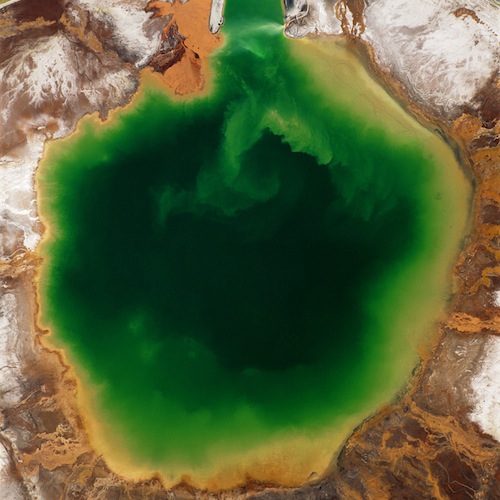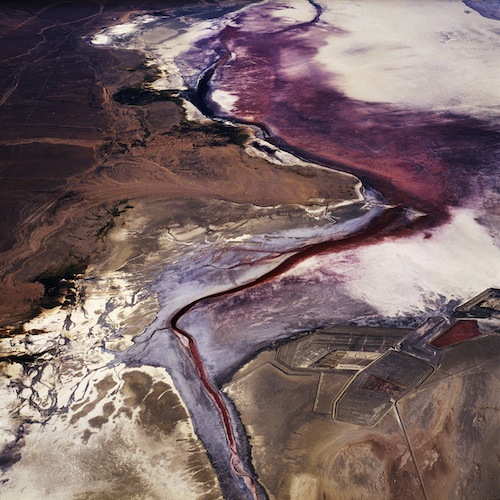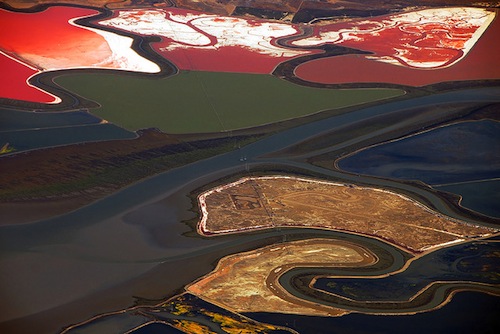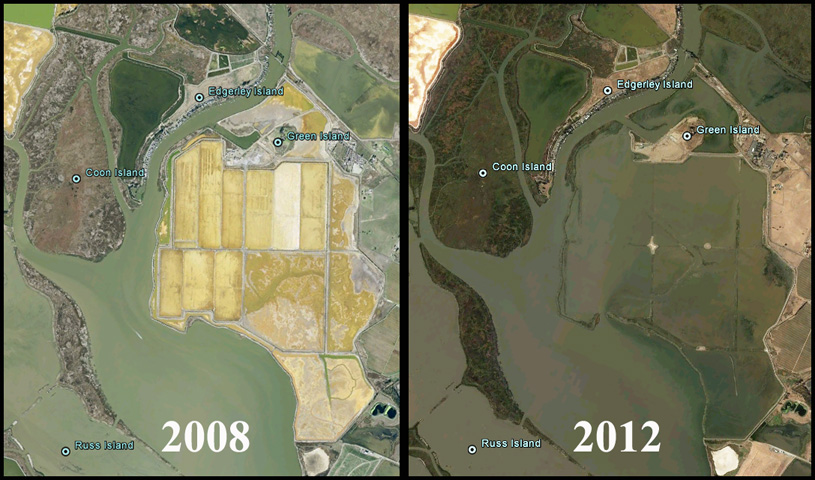
American Mine (Carlin, NV 1), 2007
Image Credit: David Maisel
You must be thinking, "Gosh, that's marvelous! What is it?" Well, I'll give you some hints about what it's not. It's not a computer-generated image (so you can rule out "digital vat of candy for a Willy Wonka film"). And it wasn't captured by NASA on a trip to Neptune. If you guessed geode, then you're getting warmer, but you're still way off in terms of scale. Perhaps it looks to you like a place where a leprechaun might stash his gold? Well, strangely, that guess may be closest of all.
It turns out this absolutely mesmerizing photograph by David Maisel is an aerial view of a toxic manmade pond in Carlin Trend, Nevada, "the most prolific gold mining district in the Western Hemisphere" according to Maisel's website. The disorienting quality of the photo is a hallmark of Maisel's environmental photography, which explores the visually haunting, otherworldly transformations humans inflict on the Earth's surface. For decades, Maisel has been flying over and photographing sites of environmental wreckage, like the scored and chemically soaked basins of America's pit mines or the wasted lakebeds that once supplied Los Angeles with water. Beyond increasing awareness about these environmental disasters, Maisel's photographs enact a terrifying tug-of-war between ethics and aesthetics. As viewers experience and take pleasure in their sublime beauty, they are forced into the uncomfortable knowledge that these environmentally ruinous conditions have an irresistably attractive dimension.

The Lake Project 13
Image Credit: David Maisel
My good friend and fellow graduate student Michael Roberts introduced me to David Maisel via the Smithsonian's recent blog about the photographer's new retrospective collection, Black Maps: American Landscape and the Apocalyptic Sublime. The beauty that Maisel locates in sites of terrestrial destruction--in the curves of a withered, polluted river or a network of cracks in the parched earth--instantly reminded me of the dilemma philosopher Elaine Scarry explores in her work on beauty and justice. Scarry argues that far from diverting critical attention from injustice, or masking it, beauty incites us to cherish and protect life. It seems to me that Maisel's photographs push the limits of this theory by positing the majesty and allure of catastrophic environmental wounds. If the very evidence of environmental devastation is made to look beautiful then what will compel us to save these endangered places?
It's difficult to articulate exactly how Maisel's photographs make me feel; but I can say that I don't feel complacence. Perhaps because most of the landscapes paradoxically appear beautiful while revealing signs of trauma, or a kind of pain, they allow us to consider both sensations in our minds at once. Maisel's photographs poignantly capture the dignity and beauty of the Earth even when it's under duress. And what could be more pathetic than that?

Image Credit: Jerry Ting
Maisel's work will remind anyone who has flown over the country of the strange views they've seen out the window. Personally, I think of the colored geometric pools that greet incoming planes at the San Francisco airport. I always enjoy looking at these lily-pad-like fields of water, but never knew what they were until Maisel's photos prompted me to investigate. It turns out these colored pools are industrial salt ponds, one-hundred-year-old evaporating receptacles for harvesting sea salt. They get their coloration from algae and other organisms living within them that express different colors depending on the saline levels in the pool. Though they are a historic part of the South Bay and make for a beautiful spectacle from overhead (see the image captured by an airplane passenger above) the salt ponds pose a major disturbance to the natural wetland habitat that preexisted them.

Image Credit: Save the Bay Blog
In 2003, California and federal agencies reclaimed a huge area of the shoreline for the South Bay Salt Pond Restoration Project which aims to return these altered sections of shoreline to a more natural state. The effects of this project are already visible from a bird's-eye vantage (as the photo juxtaposition above illustrates). In a weird way, the SF Salt Pond Restoration Project feels like an "undoing" of the beauty Maisel's photographs cull out of industrial landscapes. But surely we shouldn't lament the strides these dedicated environmentalists have made towards renewing the wetlands habitat, even if they mean that the South Bay will lose its landmark look. Some will prefer the aesthetic and/or nostalgic value of the "before" shot to the "after" shot despite what their conscience tells them. But the tension between our aesthetic preferences and our ethical gut isn't something we should necessarily suppress. At least that's what Maisel's photographs seem to suggest.




Recent comments
2 years 29 weeks ago
2 years 44 weeks ago
2 years 44 weeks ago
2 years 50 weeks ago
3 years 4 weeks ago
3 years 4 weeks ago
3 years 4 weeks ago
3 years 6 weeks ago
3 years 6 weeks ago
3 years 6 weeks ago